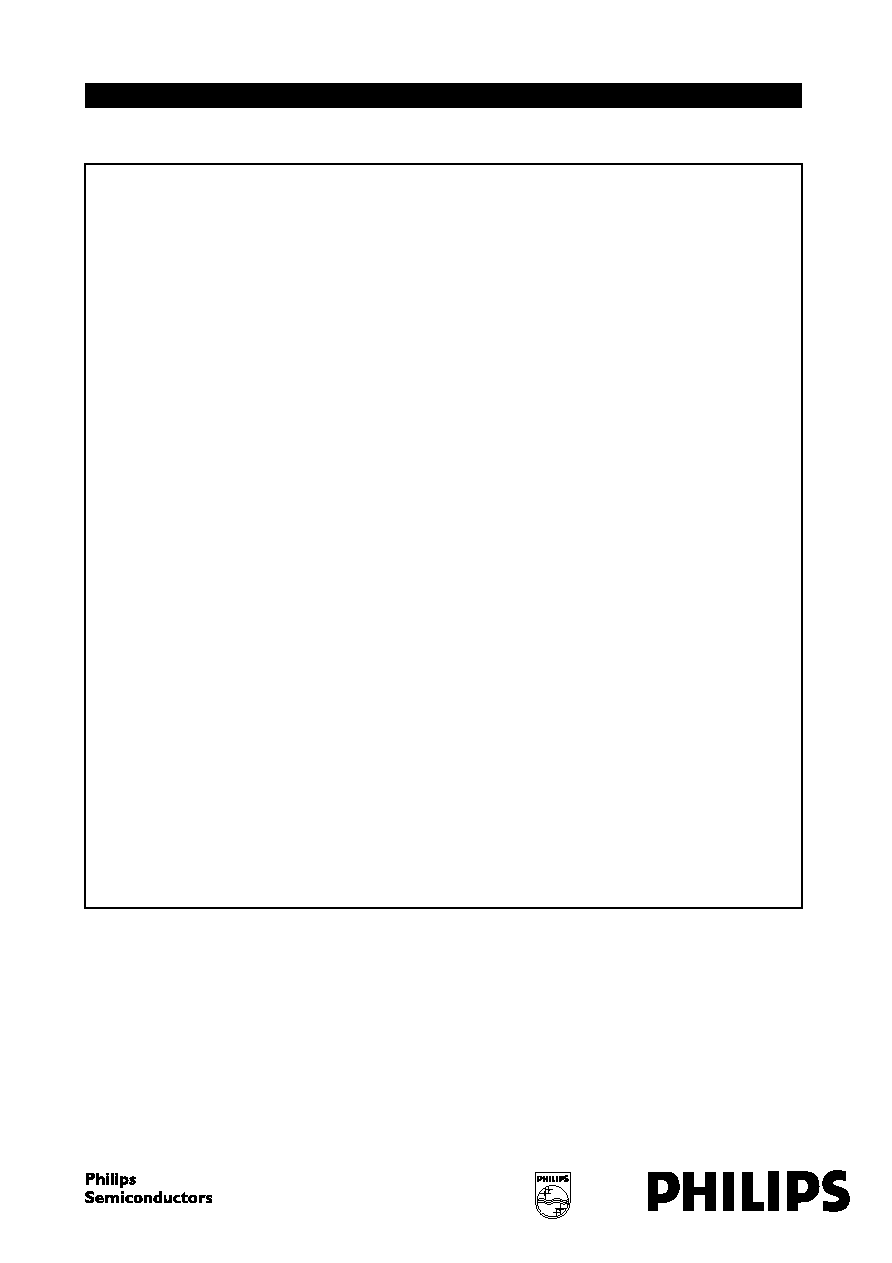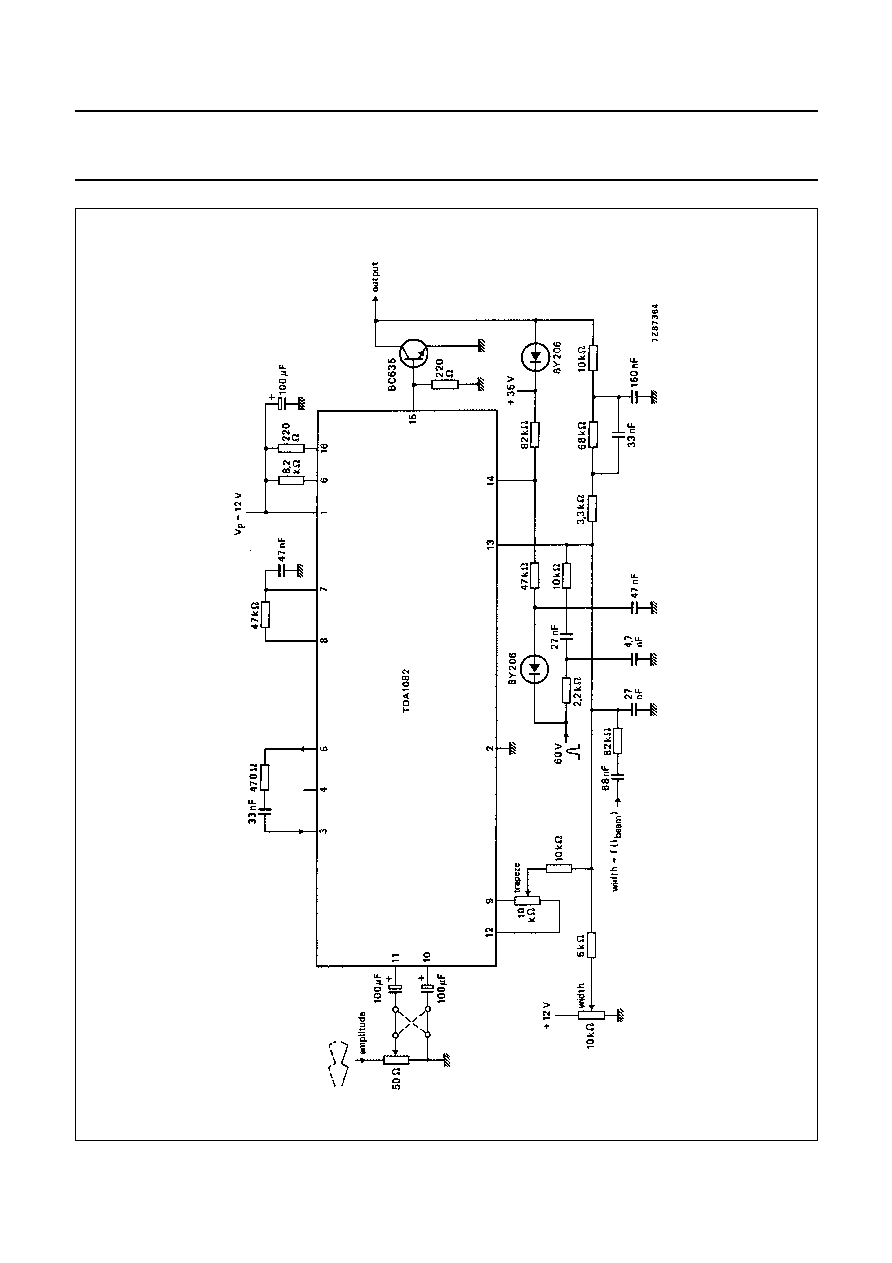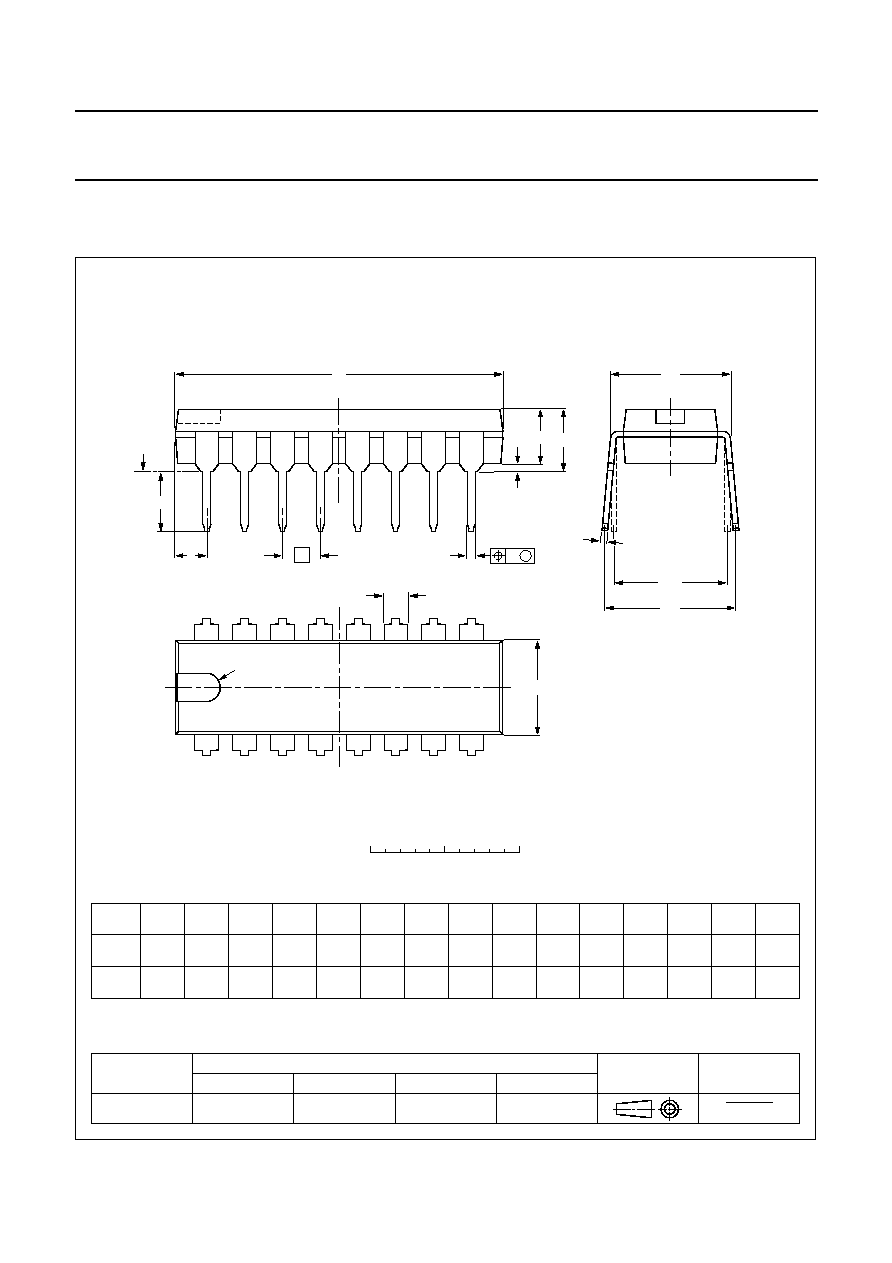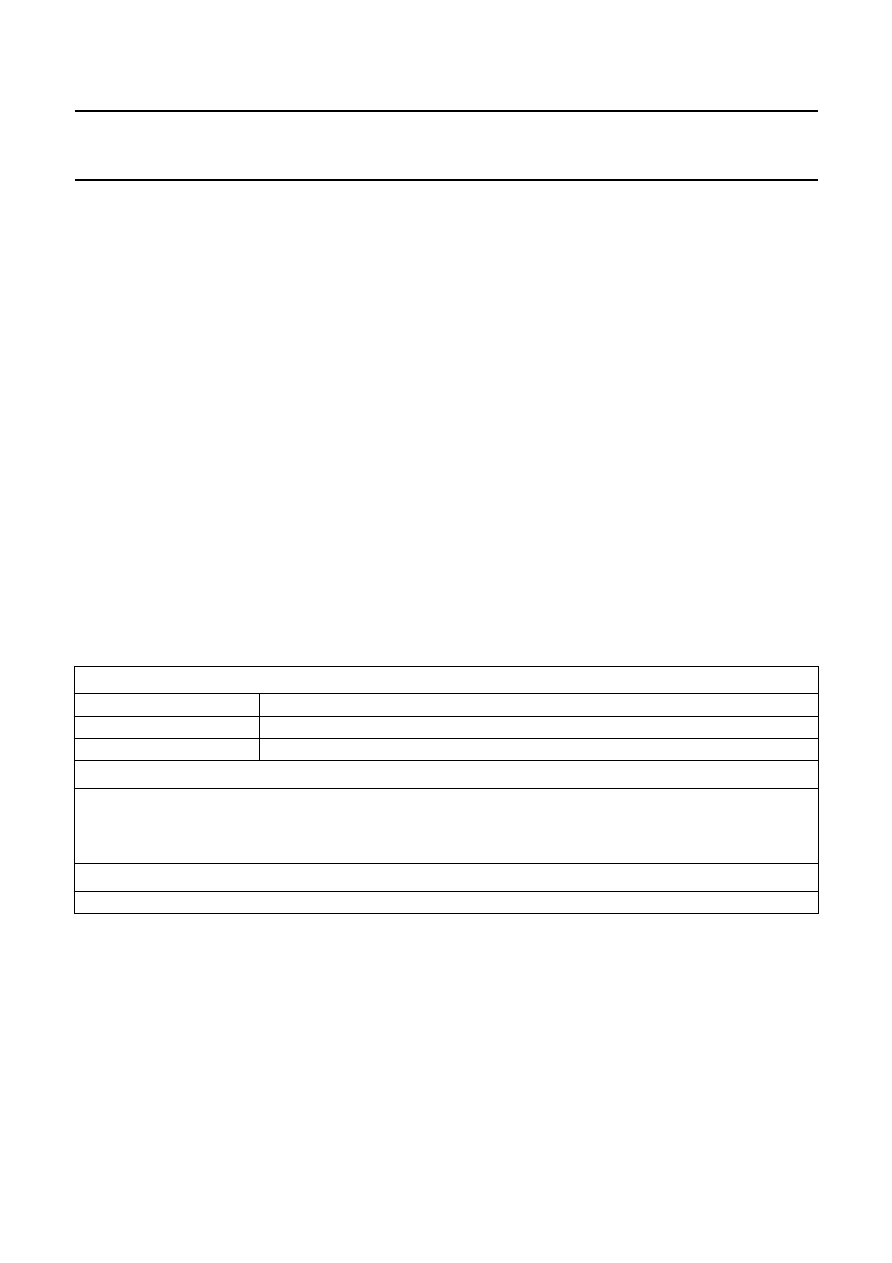 | –≠–ª–µ–∫—Ç—Ä–æ–Ω–Ω—ã–π –∫–æ–º–ø–æ–Ω–µ–Ω—Ç: TDA1082 | –°–∫–∞—á–∞—Ç—å:  PDF PDF  ZIP ZIP |
Document Outline
- GENERAL DESCRIPTION
- QUICK REFERENCE DATA
- PACKAGE OUTLINE
- RATINGS
- CHARACTERISTICS
- Supply
- Sawtooth signal
- Correcting signals
- Flyback keying
- Threshold
- Output stage
- Flyback differential amplifier
- Squaring stage
- Correction trapezoidal deformation
- Driver output
- Drift of d.c. collector voltage
- PACKAGE OUTLINE
- SOLDERING
- DEFINITIONS
- LIFE SUPPORT APPLICATIONS

DATA SHEET
Product specification
File under Integrated Circuits, IC02
March 1986
INTEGRATED CIRCUITS
TDA1082
East-West correction driver circuit

March 1986
2
Philips Semiconductors
Product specification
East-West correction driver circuit
TDA1082
GENERAL DESCRIPTION
The TDA1082 is a monolithic integrated circuit driving east-west correction of colour tubes in television receivers.
The circuit can be used for class-A and class-D operation and incorporates the following functions:
∑
differential input amplifier
∑
squaring stage
∑
differential output amplifier with driver stage
∑
protection stage with threshold
∑
switching off the correction during flyback
∑
voltage stabilizer
QUICK REFERENCE DATA
PACKAGE OUTLINE
16-lead DIL; plastic (SOT38); SOT38-1; 1996 November 19.
Supply voltage (pin 1)
V
P
typ.
12
V
Current consumption
I
P
typ.
17
mA
Total power dissipation
P
tot
max.
600
mW
Operating ambient temperature range
T
amb
0 to
+
70
∞
C
- - - - - - - - - - - - - - - - - - - - - - - - - - - - - - - - - - - - - - - - - - - - - - - - - - - - - - - - - - - - - - - -
Collector voltage drift external transistor
V
C
typ.
0,7
V

March 1986
3
Philips Semiconductors
Product specification
East-West correction driver circuit
TDA1082
Fig.1 Block diagram with external components (class-A operation). Also used as test circuit.

March 1986
4
Philips Semiconductors
Product specification
East-West correction driver circuit
TDA1082
RATINGS
Limiting values in accordance with the Absolute Maximum System (IEC 134)
CHARACTERISTICS
V
P
= 12 V (range 10,5 to 14 V); T
amb
= 25
∞
C; measured in circuit Fig.1 with colour tube A66-500X;
unless otherwise specified
Supply voltage (pin 1)
V
P
max.
16
V
Output current (pin 15)
-
I
O
max.
50
mA
Total power dissipation
P
tot
max.
600
mW
Storage temperature range
T
stg
-
25 to
+
150
∞
C
Operating ambient temperature range
T
amb
0 to
+
70
∞
C
Voltages
with respect to ground (pin 2)
min.
max.
Pins 1, 5, 7, 8, 9, 12, 13 and 16
0
16
V
Pins 3 and 4
0
-
V
Pins 10, 11 and 15
0
5
V
Currents
Pins 3, 4 and 6
-
5
mA
Pin 14
0
1,5
mA
Pins 15 and 16 (
-
I
15 and
+
I
16
)
0
50
mA
Supply
Voltage range
V
P
10,5
to
14
V
Voltage peak value
V
PM
max.
15
V
Current range
I
P
11
to
30
mA
Current typical value
I
P
typ.
17
mA
Sawtooth signal (pin 10 or 11)
Input voltage d.c. value
V
i
typ.
2,5
V
Input resistance
R
i
typ.
5,6
k
<
7,0
k
Correcting signals (pin 13)
Input voltage d.c. value
V
13
typ.
0,6
V
Input current
I
13
typ.
0,5
mA
Flyback keying (pin 3)
Input current range
I
3
0,05
to
5
mA
Peak value, d = 5%
I
3
typ.
20
mA
Threshold (pin 14)
Input voltage at I
14
= 200
µ
A
for switching off the driver stage
V
i
typ.
8
V
7,2
to
8,8
V

March 1986
5
Philips Semiconductors
Product specification
East-West correction driver circuit
TDA1082
Output stage (pin 6)
Generator current
I
6
typ.
1
mA
Flyback differential amplifier (pin 5)
D.C. value output voltage
V
5
typ.
6
V
Output resistance
R
5
typ.
5,6
k
Squaring stage (pin 7)
D.C. value output voltage
V
7
typ.
6
V
Peak to peak value output voltage
V
7(p-p)
typ.
1,5
V
Output resistance
R7
5,6
to
9,4
k
typ.
7,5
k
Correction trapezoidal deformation (pins 9 and 12)
D.C. voltage
V
9, 12
typ.
5
V
Output resistance
R
9, 12
typ.
7,5
k
Driver output (pin 15)
Output current
-
I
15
<
50
mA
Drift of d.c. collector voltage
Of external transistor in closed loop
T
amb
= 15 to 70
∞
C; V
CO
= 8 V
V
C
typ.
0,7
V

March 1986
6
Philips Semiconductors
Product specification
East-West correction driver circuit
TDA1082
Fig.2 Application circuit E-W-correction (class-D operation).

March 1986
7
Philips Semiconductors
Product specification
East-West correction driver circuit
TDA1082
PACKAGE OUTLINE
UNIT
A
max.
1
2
b
1
c
E
e
M
H
L
REFERENCES
OUTLINE
VERSION
EUROPEAN
PROJECTION
ISSUE DATE
IEC
JEDEC
EIAJ
mm
inches
DIMENSIONS (inch dimensions are derived from the original mm dimensions)
SOT38-1
92-10-02
95-01-19
A
min.
A
max.
b
max.
w
M
E
e
1
1.40
1.14
0.055
0.045
0.53
0.38
0.32
0.23
21.8
21.4
0.86
0.84
6.48
6.20
0.26
0.24
3.9
3.4
0.15
0.13
0.254
2.54
7.62
0.30
8.25
7.80
0.32
0.31
9.5
8.3
0.37
0.33
2.2
0.087
4.7
0.51
3.7
0.15
0.021
0.015
0.013
0.009
0.01
0.10
0.020
0.19
050G09
MO-001AE
M
H
c
(e )
1
M
E
A
L
seating plane
A
1
w
M
b
1
e
D
A
2
Z
16
1
9
8
b
E
pin 1 index
0
5
10 mm
scale
Note
1. Plastic or metal protrusions of 0.25 mm maximum per side are not included.
(1)
(1)
D
(1)
Z
DIP16: plastic dual in-line package; 16 leads (300 mil); long body
SOT38-1

March 1986
8
Philips Semiconductors
Product specification
East-West correction driver circuit
TDA1082
SOLDERING
Introduction
There is no soldering method that is ideal for all IC packages. Wave soldering is often preferred when through-hole and
surface mounted components are mixed on one printed-circuit board. However, wave soldering is not always suitable for
surface mounted ICs, or for printed-circuits with high population densities. In these situations reflow soldering is often
used.
This text gives a very brief insight to a complex technology. A more in-depth account of soldering ICs can be found in our
"IC Package Databook" (order code 9398 652 90011).
Soldering by dipping or by wave
The maximum permissible temperature of the solder is 260
∞
C; solder at this temperature must not be in contact with the
joint for more than 5 seconds. The total contact time of successive solder waves must not exceed 5 seconds.
The device may be mounted up to the seating plane, but the temperature of the plastic body must not exceed the
specified maximum storage temperature (T
stg max
). If the printed-circuit board has been pre-heated, forced cooling may
be necessary immediately after soldering to keep the temperature within the permissible limit.
Repairing soldered joints
Apply a low voltage soldering iron (less than 24 V) to the lead(s) of the package, below the seating plane or not more
than 2 mm above it. If the temperature of the soldering iron bit is less than 300
∞
C it may remain in contact for up to
10 seconds. If the bit temperature is between 300 and 400
∞
C, contact may be up to 5 seconds.
DEFINITIONS
LIFE SUPPORT APPLICATIONS
These products are not designed for use in life support appliances, devices, or systems where malfunction of these
products can reasonably be expected to result in personal injury. Philips customers using or selling these products for
use in such applications do so at their own risk and agree to fully indemnify Philips for any damages resulting from such
improper use or sale.
Data sheet status
Objective specification
This data sheet contains target or goal specifications for product development.
Preliminary specification
This data sheet contains preliminary data; supplementary data may be published later.
Product specification
This data sheet contains final product specifications.
Limiting values
Limiting values given are in accordance with the Absolute Maximum Rating System (IEC 134). Stress above one or
more of the limiting values may cause permanent damage to the device. These are stress ratings only and operation
of the device at these or at any other conditions above those given in the Characteristics sections of the specification
is not implied. Exposure to limiting values for extended periods may affect device reliability.
Application information
Where application information is given, it is advisory and does not form part of the specification.







